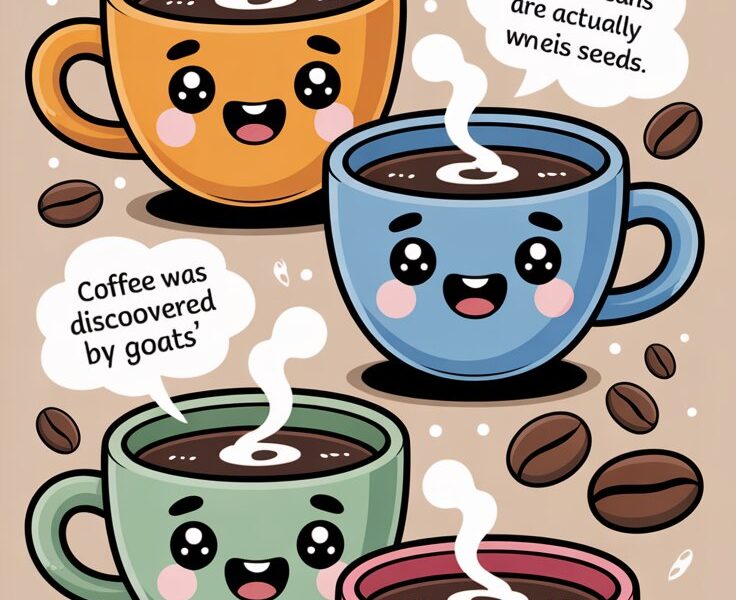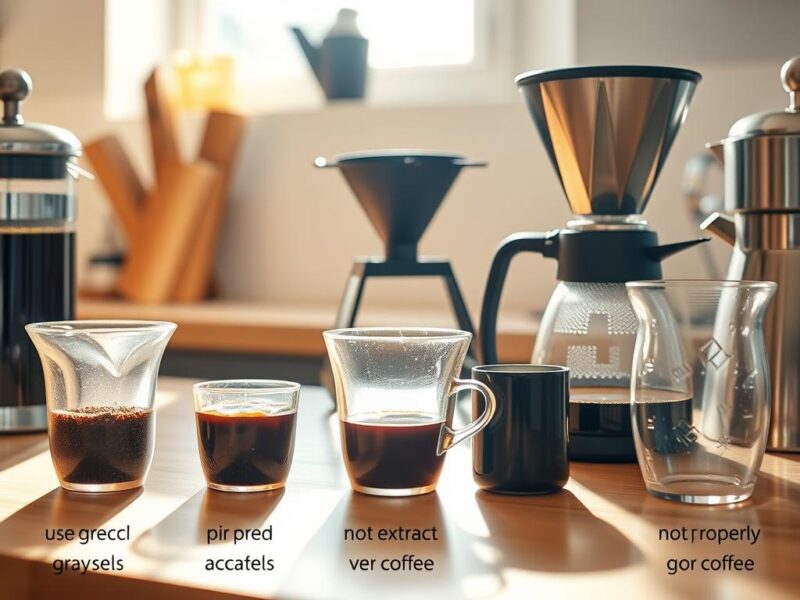Did you know the average American drinks 3 cups of coffee daily? That’s enough to fill a bathtub every month! This beloved beverage has fueled humanity for centuries, starting with Ethiopian herders who noticed goats dancing after eating mysterious red berries.
This post contains affiliate links. If you purchase through these links, I may earn a small commission at no extra cost to you. Learn more here.
Today, coffee connects cultures worldwide. But there’s more to your morning cup than caffeine. Those aromatic beans begin as green seeds inside coffee cherries – yes, coffee grows on fruit trees! The roasting process transforms them into the rich, brown gems we grind and brew.
While the U.S. loves its coffee, Nordic countries like Finland and Norway top global consumption charts. Their residents drink nearly twice as much per person! This drink’s journey from ancient Ethiopia to modern cafes reveals surprising twists we’ll explore together.
Key Takeaways
- Coffee beans originate from bright red coffee cherries
- Americans consume over 3 cups daily on average
- Nordic nations lead in per capita coffee consumption
- Roasting transforms green beans into aromatic favorites
- Historical roots trace back to Ethiopian traditions
Ready to become a coffee expert? We’ll unpack these java truths and more – from brewing secrets to global rituals. Keep reading to savor every surprising detail about your favorite drink.
Welcome to the World of Coffee
Picture this: your morning alarm rings, and within minutes, the rich aroma of freshly ground beans fills your kitchen. Coffee isn’t just a drink—it’s a daily ritual connecting millions worldwide. From Tokyo’s kissaten cafes to Rome’s espresso bars, this beverage bridges cultures through shared moments of warmth and energy.
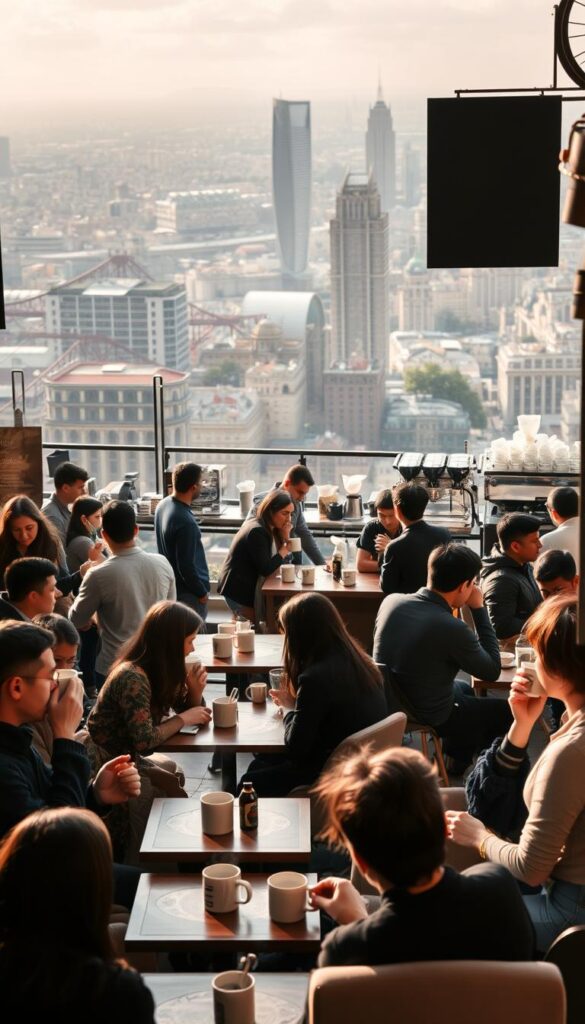
What Makes Coffee So Beloved Today?
People crave coffee for more than its caffeine kick. It sparks conversations during work breaks, fuels creative brainstorming sessions, and turns strangers into friends at local cafes. The drink’s versatility shines through brewing styles—whether you prefer a quick drip brew or a slow-poured latte art masterpiece. Even tea drinkers often swap their cups for coffee during hectic weeks!
How Coffee Integrates Into Your Daily Routine
Your day likely revolves around coffee rituals. That first cup jumpstarts your morning. The afternoon pour-over becomes a mindful pause. Globally, Nordic countries like Finland average four cups daily, turning coffee into a social glue. At home, brewing methods adapt to your pace: espresso shots for rushed mornings, French presses for lazy Sundays.
This global obsession goes beyond taste. Coffee shops serve as remote offices, study hubs, and first-date venues. Whether you’re sipping Ethiopian single-origin or a caramel macchiato, every cup tells a story—one that starts in your kitchen and spans the world.
The Origins and Historical Journey of Coffee
Have you ever wondered how your morning brew became a global phenomenon? Its story begins in Ethiopia’s misty highlands, where legend claims a curious goat herder changed history forever.
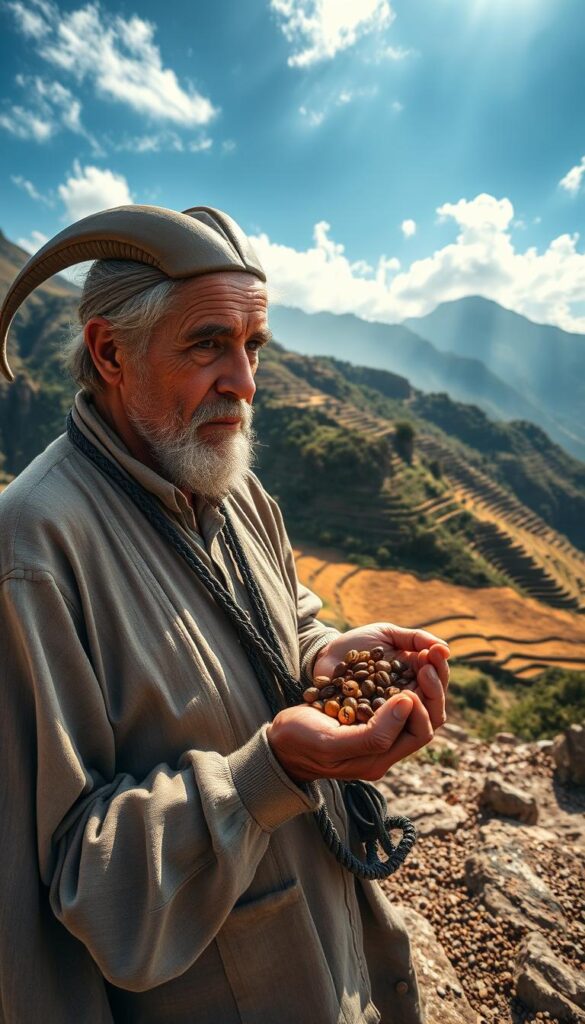
The Ethiopian Start and the Legend of the Goat Herder
Meet Kaldi – the 9th-century herder who noticed his goats dancing after eating red berries. Monks soon brewed the seeds inside these “coffee cherries” into a drink to stay alert during prayers. Early processing involved drying the fruit and roasting the raw green beans over fire.
By the 15th century, cultivation spread to Yemen. Traders carried the beans in leather pouches, planting them along caravan routes. The drink became known as “qahwa” – Arabic for “that which prevents sleep.”
How Coffee Traveled Across the Globe
Venetian merchants first brought coffee to Europe in 1615. By 1650, London’s coffee houses buzzed with political debates and business deals. The Dutch later smuggled plants to Java, creating new growing regions.
Historical methods still shape your cup today. Turkish ibrik brewing inspired modern espresso machines. Ethiopian ceremonies emphasizing slow roasting remind us to savor each sip. From ancient monasteries to your kitchen counter, coffee’s journey spans continents and centuries.
From Bean to Brew: Understanding Coffee Production
Ever peeled back the layers of your morning coffee? Those dark roasted beans begin life as seeds inside bright red coffee cherries – sweet fruits growing on tropical plants. This fruity origin explains why unroasted coffee beans smell grassy rather than rich.

Nature’s Hidden Treasure
Workers handpick cherries at peak ripeness, often sorting them multiple times. Inside each cherry lie two green seeds – what we mistakenly call beans. The fruit pulp gets removed through washing or sun-drying methods, impacting final taste notes like berry or caramel.
Transformation Through Fire
Raw green beans undergo roasting at 400°F to unlock aromas. Lighter roasts preserve floral hints, while darker ones develop chocolatey depth. Quality control happens daily – experts sample batches to ensure consistent flavor profiles.
Three factors shape your cup’s personality:
- Harvest timing: Early picks yield acidic tones
- Processing style: Washed vs. natural methods alter sweetness
- Roast duration: Minutes determine boldness
Specialty coffee production often uses shade-grown plants and slower roasting. Next time you sip, remember: that brew contains centuries of agricultural wisdom and modern science.
Unveiling Coffee’s Unique Production Cultures
Ever tasted coffee and wondered why it bursts with chocolatey notes or floral hints? The answer lies in how—and where—it’s grown. From sprawling Brazilian plantations to Indonesian jungles, production methods shape every sip you take.
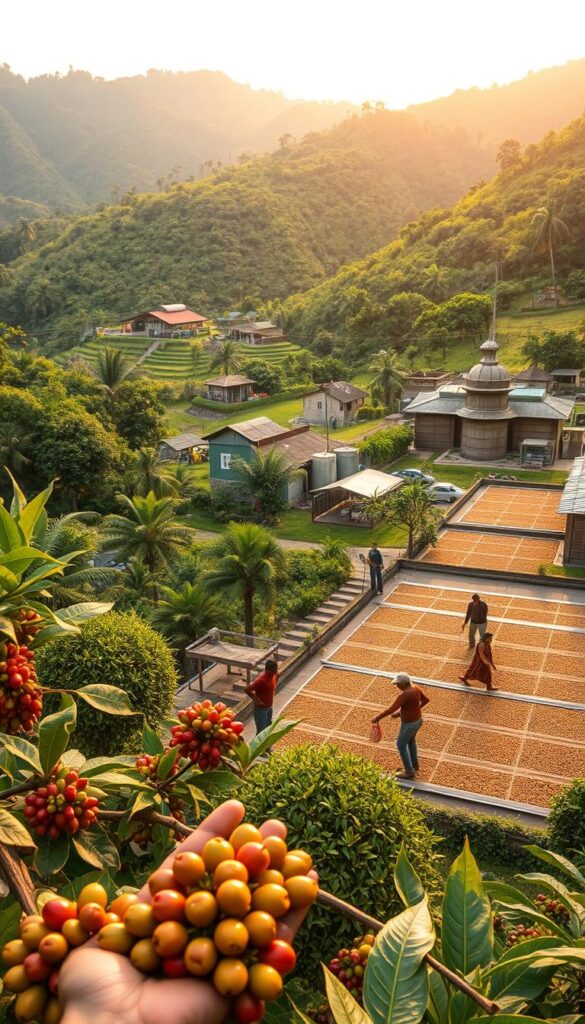
Brazil’s Dominance in Coffee Production
Brazil grows nearly 30% of the world’s coffee, making it the undisputed leader. Its vast landscapes and tropical climate create ideal conditions for both Arabica and Robusta beans. Farmers here harvest enough each year to supply over 70 countries!
This scale impacts your daily cup. Brazilian beans often form the base of espresso blends and grocery store coffees. But quantity doesn’t mean sacrificing quality—regions like Minas Gerais produce award-winning lots with caramel sweetness.
Specialty Coffees: Kopi Luwak and Beyond
At the other extreme lies Kopi Luwak, the infamous brew made from beans eaten and excreted by civets. This Indonesian specialty costs up to $600 per pound due to its labor-intensive process. Enzymes in the animals’ digestive systems alter the beans’ flavor, creating a smoother profile.
While Kopi Luwak faces ethical debates, it highlights how production culture drives innovation. Other rarities include Black Ivory Coffee (elephant-processed) and Yemeni beans dried on stone rooftops. These methods prioritize tradition over mass appeal.
Climate and soil differences explain why Brazilian coffee tastes different from Ethiopian or Colombian varieties. High-altitude regions yield brighter acidity, while volcanic soils add mineral complexity. Next time you brew, consider the journey those beans took—from exotic farms to your favorite mug.
10 Fun Facts About Coffee You Didn’t Know
Think your daily brew is just a caffeine fix? These eye-opening tidips will change how you view your cup forever. Let’s spill the beans on java’s best-kept secrets.
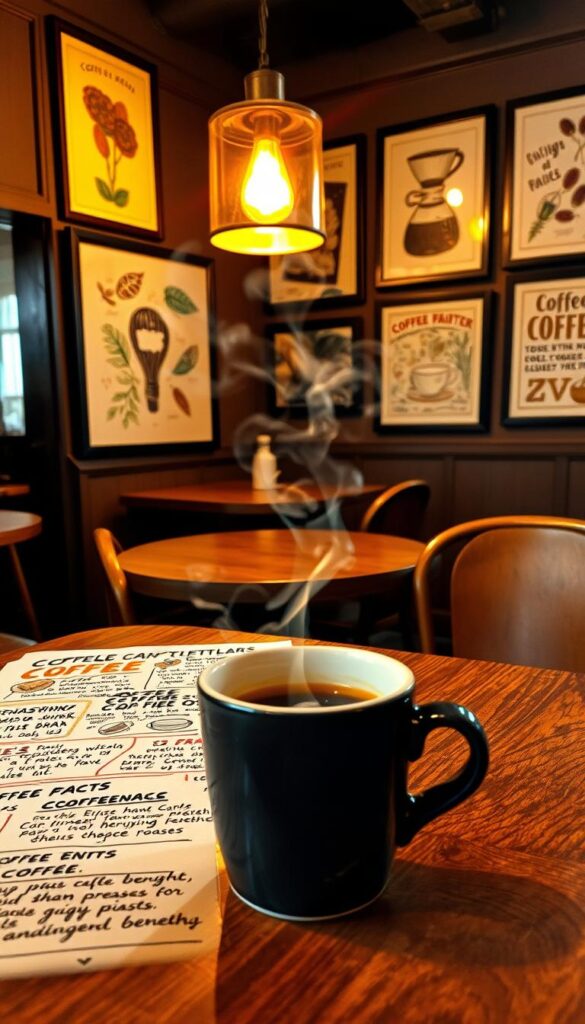
1. Light roasts pack more punch – they retain 10% more caffeine than dark roasts despite tasting milder
2. Caffeine has no natural flavor – its bitterness comes from roasting temperatures exceeding 400°F
3. Espresso contains less caffeine per ounce than drip coffee – but you drink it faster
4. Decaf isn’t caffeine-free – it still delivers 3% of the original kick
5. New Yorkers drink 7 times more coffee than other U.S. cities – roughly 4 cups daily
☕ Fun fact overload? Take a sip break!
Want to taste what makes coffee so legendary? Explore rich, aromatic blends from The Coffee Bean & Tea Leaf® — they’ve been perfecting brews since 1963.
6. The world’s priciest beans involve animal digestion – Kopi Luwak costs $600/lb
7. Early coffee houses charged 1 penny for entry – called “penny universities” for their intellectual debates
8. Iced coffee predates hot brewing – 19th-century sailors mixed grounds with cold water
9. Bananas share 50+ flavor compounds with roasted beans – try pairing them!
10. Your sense of smell enhances coffee’s taste – pinch your nose while sipping to test it
These surprises show why this beverage remains endlessly fascinating. Whether you prefer light roasts or exotic brews, every sip connects you to centuries of discovery. Who knew your morning ritual hid so much intrigue?
Exploring Creative Coffee Culture in the United States
Imagine stepping into a café where your latte arrives with edible glitter or your espresso gets infused with nitrogen bubbles. Across the U.S., coffee shops are transforming the simple act of drinking a cup of coffee into multisensory experiences. These spaces blend art, science, and community, redefining what it means to enjoy a daily brew.

Where Innovation Meets the Coffee Cup
Trendsetting cafés experiment with techniques like flash-chilled nitro brews and siphon brewing that resembles chemistry labs. In cities like Portland and Austin, baristas craft drinks using locally roasted coffee beans paired with unexpected ingredients – think lavender-infused cold foam or chili-spiced mochas. Some even offer espresso tonics mixed with artisanal bitters.
Regional conditions shape flavor adventures too. Coastal shops highlight bright acidity from high-altitude coffee plants, while Southern roasters emphasize chocolatey depth through slower roasting. This localization creates distinct profiles you won’t find in other countries.
Three ways U.S. cafés stand out globally:
- Interactive brewing stations where you customize grind size and water temperature
- Latte art competitions pushing creative boundaries
- Coffee-tasting flights comparing single-origin beans
These spaces double as community hubs. Freelancers brainstorm over pour-overs, while coffee workshops turn novices into home-brew experts. By merging craftsmanship with connection, American coffee culture proves every cup tells a story – and now, you’re part of it.
The Science Behind Your Favorite Cup
Your morning cup holds more secrets than a spy novel—let’s decode its hidden chemistry. Those rich flavors and energizing effects come from precise reactions between heat, water, and coffee beans. Whether you prefer light citrus notes or bold chocolate tones, science shapes every sip.
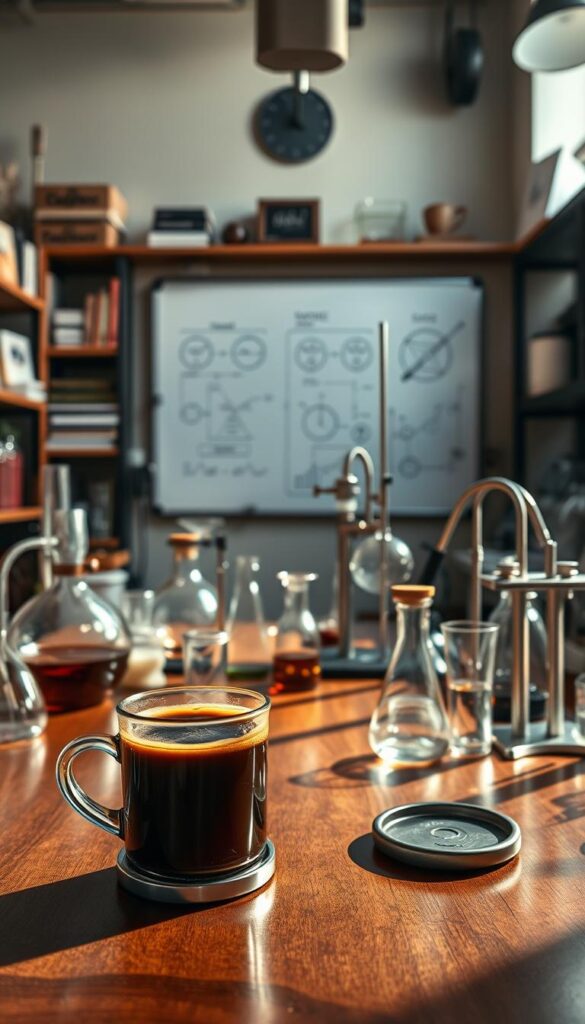
Understanding Caffeine Variations in Light and Dark Roasts
Contrary to popular belief, light roasts pack more caffeine per scoop. The longer beans roast, the more they lose mass through evaporation. “A dark roast’s bold flavor tricks us into thinking it’s stronger,” explains master roaster Elena Torres. “But ounce for ounce, lighter beans deliver more kick.”
How Brewing Techniques Impact Flavor and Aroma
Your water temperature acts like a flavor key. Too hot (over 205°F), and bitter oils dominate. Too cool (under 195°F), and fruity acids stay locked in. Grind size matters too—espresso’s fine powder extracts quickly, while French press coarse grounds need 4 minutes to release their depth.
Three scientific tips for better taste today:
- Use a kitchen scale—18g beans to 300g water hits the “golden ratio”
- Preheat your mug to keep aromas from cooling too fast
- Try blooming pour-overs: pour twice the coffee’s weight in water, wait 30 seconds, then continue
Modern innovations build on ancient wisdom. The Turkish ibrik’s slow boil inspired today’s espresso machines, while Ethiopian jebena pots show how controlled pouring enhances clarity. Next time you brew, remember—you’re not just making a drink. You’re conducting delicious chemistry.
Coffee Varieties and Their Distinct Personalities
What if your morning brew could tell stories? Each sip reveals the unique character of its beans—nature’s fingerprint shaped by soil, climate, and centuries of cultivation. The four main coffee types each bring their own drama to your cup.
Arabica, Robusta, Liberica, and Excelsa Explained
Arabica rules the world with 60% of global production. Grown in high-altitude regions like Colombia and Ethiopia, its beans deliver floral notes and mild acidity. “Arabica’s like a jazz solo—complex and smooth,” says Guatemalan grower Luis Martinez.
Robusta packs double the caffeine and thrives in lowland areas like Vietnam. Its bold, earthy flavor shines in espresso blends. While often seen as Arabica’s rugged cousin, specialty Robusta grades surprise with chocolate undertones.
Meet the rare rebels:
- Liberica: Peanut-shaped beans from West Africa with smoky, woody flavors
- Excelsa: Tart, fruity profiles from Southeast Asian plants resistant to drought
These beans aren’t actually beans—they’re seeds inside crimson coffee cherries. Historical trade routes made Arabica dominant, but climate shifts are reviving interest in hardy Liberica and Excelsa plants.
Your brewing method should match the bean’s personality. Try pour-over for delicate Arabica, or French press to highlight Robusta’s intensity. Next time you shop, check labels—you might discover a new favorite character in coffee’s flavorful cast.
How Coffee Impacts Health and Well-Being
What if your daily coffee ritual does more than wake you up? Science reveals this beverage offers surprising perks when enjoyed mindfully. Let’s separate fact from fiction about your favorite brew.
The Benefits and Myths of Caffeine
Moderate coffee consumption (3-4 cups daily) links to lower risks of type 2 diabetes and heart disease. Antioxidants in beans fight inflammation, while caffeine sharpens focus. “The key is balance,” notes nutritionist Dr. Alicia Tan. “Overdoing it can cause jitters, but sensible intake supports wellness.”
Common myths crumble under scrutiny:
- Myth: Dark roasts have more caffeine (truth: light roasts retain 10% more)
- Myth: Espresso dehydrates you (truth: fluid content offsets mild diuretic effects)
- Myth: You shouldn’t drink coffee after noon (truth: caffeine half-life varies by person)
Why Decaf Still Has a Little Kick
Switching to decaf doesn’t mean going caffeine-free. The Swiss Water Process removes 97% of caffeine, leaving about 3%—equivalent to one regular coffee sip per cup. This trace amount explains why some still feel a mild lift.
Studies show decaf drinkers get similar antioxidant benefits without sleep disruption. Whether you choose regular or decaf, timing matters. Enjoy your last cup 6 hours before bed for uninterrupted rest.
Your coffee habit becomes healthier when paired with water intake and varied diets. Those who drink coffee moderately often report better mood and sustained energy through the day—proof that smart sipping pays off.
Coffee’s Ongoing Legacy in History and Society
Where did revolutionaries and artists find inspiration centuries ago? Not in boardrooms or libraries—but in buzzing coffee houses. These spaces became the original social networks, brewing ideas alongside steaming cups of ambition.
London’s 17th-century “penny universities” charged one cent for entry and endless debates. Patrons shaped insurance concepts at Lloyd’s Coffee House and plotted revolutions at Paris’ Café Procope. These hubs proved people gathering over coffee could literally change the world.
From Enlightenment to Entrepreneurship
Modern cafes carry this torch. Your neighborhood spot serves triple roles: office for remote workers, stage for open-mic nights, and sanctuary for book clubs. Like their ancestors, today’s coffee shops thrive as neutral grounds where diverse minds collide.
Three threads connect past and present:
- Community creation: Ethiopian coffee ceremonies still unite villages
- Idea exchange: Silicon Valley startups often launch over cold brews
- Cultural fusion: Melbourne’s cafes blend Italian espresso traditions with Australian brunch culture
While brewing methods evolved, the core remains. Whether sipping Yemeni qishr or a pumpkin spice latte, you’re part of a 500-year-old ritual. Those humble beans continue fueling connections—proof that the best beverage ideas stand the test of time.
Conclusion
Ever considered how a simple cup bridges continents and centuries? From Ethiopian highlands where curious goats first nibbled red berries to modern cafés serving nitro brews, this global obsession thrives through its rich legacy. Those humble seeds you grind each morning carry stories of innovation—whether processed by tropical plants or perfected through roasting science.
Your daily brew reflects centuries of craft. Light roasts preserve floral hints from high-altitude beans, while precise water temperatures unlock hidden flavors. Research continues revealing benefits—moderate consumption may support heart health while connecting people across cultures.
Nordic countries sip four cups daily, New Yorkers fuel fast-paced lives, and Ethiopian ceremonies honor tradition. Yet every cup shares a common thread: it transforms beans into moments of connection. Modern studies and ancient practices agree—this beverage offers more than caffeine.
Next time you pour a mug, remember its journey. Explore single-origin varieties, experiment with brewing methods, or chat with local roasters. Join the worldwide conversation that started with a goat herder and now spans your kitchen counter. After all, great ideas—like great coffee—deserve to be shared.
Now that you’ve learned some of coffee’s quirkiest secrets, why not enjoy a cup that lives up to the history?
💡 Bring the coffeehouse home with bold, small-batch beans from CoffeeBean.com — your next brew might just be the most interesting part of your day.

